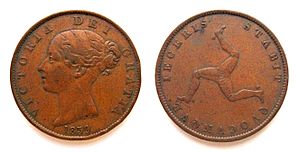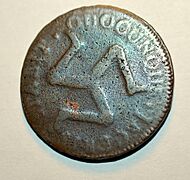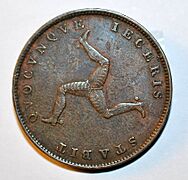Manx pound facts for kids
Quick facts for kids Manx pound |
|
|---|---|
| ISO 4217 Code | none |
| User(s) | |
| Inflation | 3.6% |
| Source | The World Factbook, 2004 |
| Pegged with | Pound sterling |
| Subunit | |
| 1⁄100 | penny |
| Symbol | £ |
| penny | p |
| Plural | |
| penny | pence |
| Coins | 1p, 2p, 5p, 10p, 20p, 50p, £1, £2, £5 |
| Banknotes | £1, £5, £10, £20, £50 |
The Manx pound (abbreviation: IMP; sign: £) is the money used on the Isle of Man. It is called Punt Manninagh in the Manx language. The Manx pound is worth exactly the same as the British pound. One Manx pound is made up of 100 pence. The Isle of Man Government prints its own banknotes and makes its own coins.
Contents
How the Manx Pound Works
The Isle of Man has a special money agreement with the United Kingdom. It's like a one-way currency union. This means that British money is also accepted as legal payment on the Isle of Man. The Manx government makes sure its own notes and coins are backed up by Bank of England notes.
Exchanging Manx Money
You can exchange Manx government notes for Bank of England notes at the Isle of Man Bank. They will be exchanged at the same value. All notes and coins that are legal payment in the UK are also legal payment on the Isle of Man.
Manx Money in the UK
Unlike Scottish or Northern Irish banknotes, Manx notes are not legal payment in the UK. This is because the British Parliament has not approved them. The UK government or the Bank of England do not guarantee Manx notes and coins. However, the Isle of Man Treasury promises to exchange Manx Pound banknotes for Bank of England notes. This rule helps control how much Manx money is printed.
Manx Pound Code
The international system for currency codes, ISO 4217, does not have a special code for the Manx pound. However, you might sometimes see it called IMP. The letters "IM" are the official code for the Isle of Man.
History of Manx Money
The first Manx coins were made in 1668 by a merchant named John Murrey in Douglas. These "Murrey Pennies" were worth the same as English pennies. In 1679, they became official money.
Changes in Coin Value
It was hard to keep enough coins on the island. So, in 1692, the value of Manx coins was lowered. For example, a British crown was worth 5 shillings and 4 pence in Manx money. The government also stopped people from taking money off the island.
In 1696, the value was lowered again. English silver and gold coins were worth 14 Manx pence for every shilling. This meant that £100 in British money was worth £116 13s 4d in Manx money. Manx copper coins were used alongside British silver and gold coins until 1840.
First Government Coins
In 1708, the Isle of Man Government asked the Royal Mint in England to make coins for them. But Sir Isaac Newton, who was in charge of the Royal Mint, said no. So, the Isle of Man Government started making its own coins in 1709. These coins became official money in 1710.
The "Copper Row" Riots
Because Manx and British coins looked similar, people would sometimes try to pass off Manx coins as British ones in Great Britain. This made a profit for them but caused a shortage of copper coins on the Isle of Man by 1830.
To fix this, the British government decided in 1839 that only British coins would be used on the island. This made many islanders angry, and there were riots in Douglas and Peel. These events were called the "Copper Row" riots.
The Royal Mint then made £1,000 worth of copper coins for the Isle of Man. After 1839, no more Manx coins were made until 1971. British coins slowly replaced them. Manx coins were still legal payment until 1971, when the UK switched to decimal currency.
Decimalisation and New Coins
In 1971, the UK changed its money system to a decimal currency. This meant one pound was divided into 100 pence. The Isle of Man Government, which had been printing its own banknotes for ten years, also decided to make its own decimal coins. These new coins were introduced in 1971.
Manx Coins Today
Early Designs
The "Murrey Pennies" from 1668 were the first to show the 'triskeles' symbol. This symbol looks like three legs joined together. They also had the motto "Quocunque Gesseris Stabit" (which means "Wherever you throw it, it will stand"). Both the triskeles and the motto are still on Manx coins today.
Government Coin Designs
The first government coins in 1709 and 1733 showed the crest of the Stanley family, who were the Lords of Mann. This crest had an eagle and a child. Later coins in 1758 showed the ducal coronet of the Duke of Atholl.
In 1786, new coins featured the head of King George III, who was then the Lord of Mann. These coins also had the triskeles and Manx motto. More coins were made in 1798 and 1813. They were the same size and material as English coins.
In 1839, the Royal Mint made new copper coins for the Isle of Man. These had the head of Queen Victoria. These were the last Manx coins made until 1971.
- Duke of Atholl coin ; Bank {{frac|1|2}}d ; Victoria 1d
Modern Decimal Coins
In 1971, new coins were introduced: 1⁄2, 1, 2, 5, 10, and 50 new pence. They were the same size and made of the same materials as British coins. From 1972, a company called Pobjoy Mint started making Manx coins. The word "new" was taken off the coins in 1976.
A £1 coin was introduced in 1978, but people preferred the £1 banknote. In 1982, a 20 pence coin was added. When the UK changed its £1 notes to coins in 1983, the Isle of Man also started making £1 coins that matched the UK's. A two-metal £2 coin was introduced in 1998, just like the British one.
Manx coins show a portrait of Queen Elizabeth II on one side, similar to British coins. The words "ISLE OF MAN" are also on this side. The Manx £1 coin has a partly smooth and partly ridged edge.
Since 2017, new £1 coins made by Tower Mint have a finely-milled edge all around. The old round £1 coin stopped being legal payment in the UK in 2017. However, the Isle of Man kept its own round £1 coins as legal payment. Old British £1 coins were accepted on the Isle of Man until February 28, 2018. After that, only Manx £1 notes and coins, and the new 12-sided British £1 coins are accepted.
Manx Banknotes
In 1865, the Isle of Man Banking Company started printing £1 notes. They added £5 notes in 1894. Other banks also printed notes on the island for a while.
Government Banknotes
In 1961, the Isle of Man Government took over printing banknotes. They started with 10/-, £1, and £5 notes. In 1969, the 10/- note was replaced by a 50 new pence note. £20 notes were introduced in 1979. A plastic £1 note was made in 1983 but stopped in 1988. A £50 note was also introduced in 1983. The 50p banknote was removed in 1989.
The Isle of Man still prints a £1 note, even though the UK has stopped printing its own £1 notes (except in Scotland).
Banknote Designs
All Manx banknotes have a promise to pay the bearer. They also show Queen Elizabeth II and the triskelion (three legs emblem) with its motto. The triskelion is also used as a watermark. Each banknote shows a different famous place on the Isle of Man:
- £1 – Tynwald Hill (where the Manx parliament meets)
- £5 – Castle Rushen
- £10 – Peel Castle
- £20 – the Laxey Wheel (a large waterwheel)
- £50 – Douglas Bay
Manx Pound and the Euro
The Isle of Man Government believed that if the United Kingdom joined the euro, the island would likely join too. This is because most of the island's trade is with the UK and other European countries. Breaking away from the UK's currency would harm the island's economy.
The Isle of Man wanted to keep its own currency, even if it joined the euro. This would show its independence. It would also allow the Isle of Man Treasury to earn interest from the money it issues. They even designed Manx versions of euro coins and euro banknotes. These would have been called "substitute euros" and would have worked like the current "substitute sterling."
If the Isle of Man had adopted the euro, it might have become more attractive as a tax haven. This could have led to political pressure from European politicians. However, joining the euro was also expected to help Manx businesses and tourism by removing currency exchange costs for visitors from Europe.
See also
 In Spanish: Libra manesa para niños
In Spanish: Libra manesa para niños
- Economy of the Isle of Man
- Commemorative coins of the Isle of Man
- Alderney pound
- Guernsey pound
- Jersey pound








